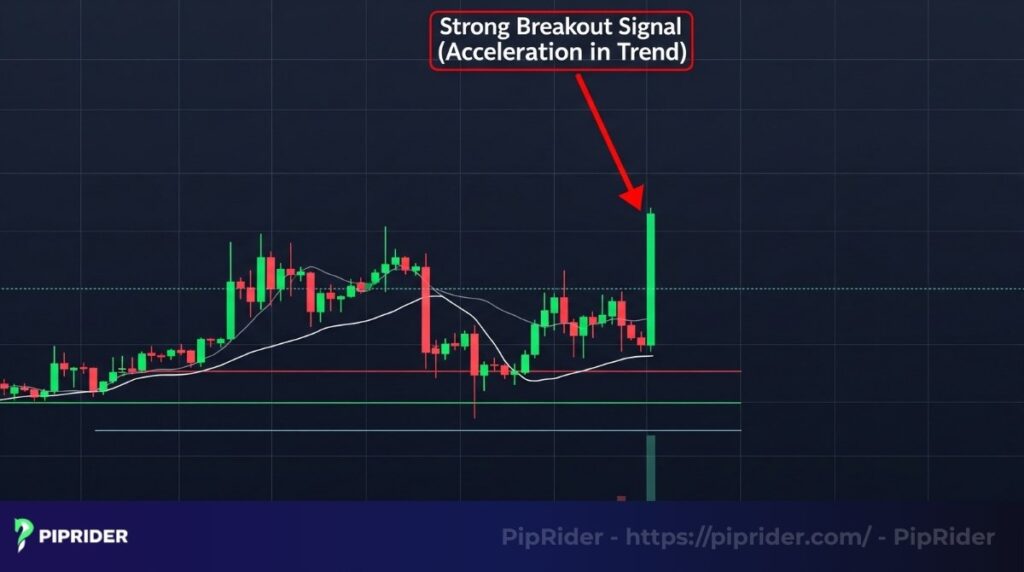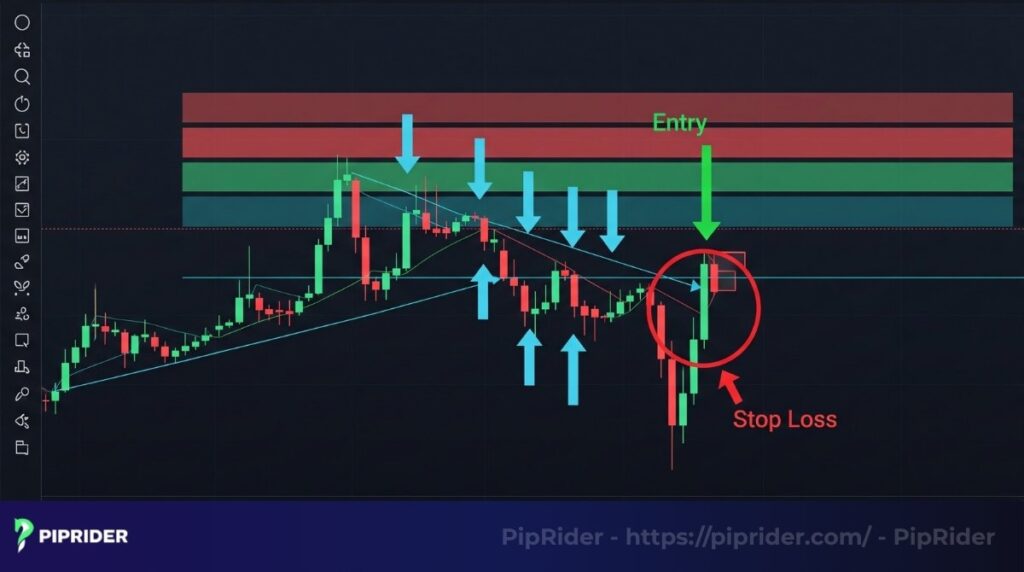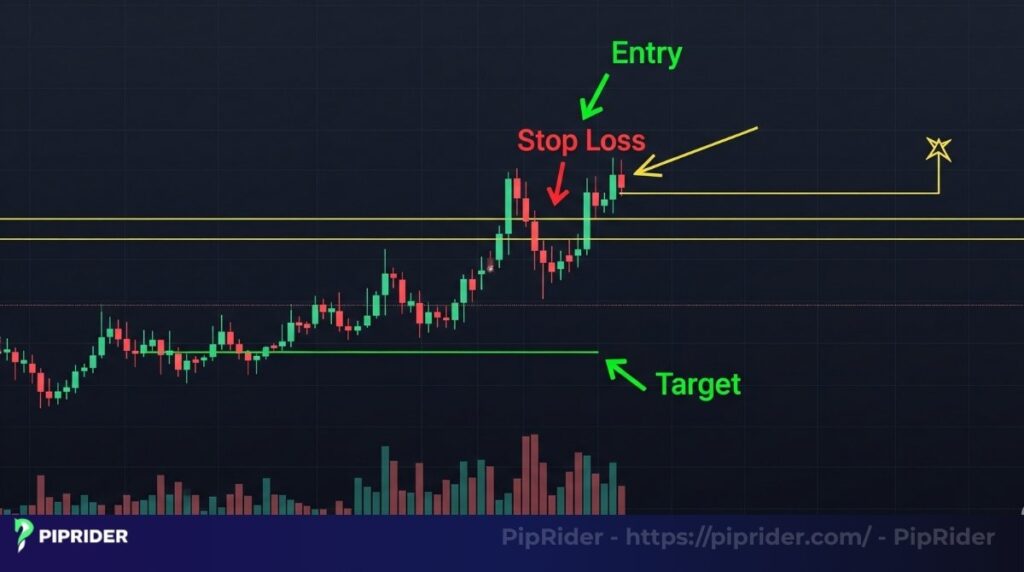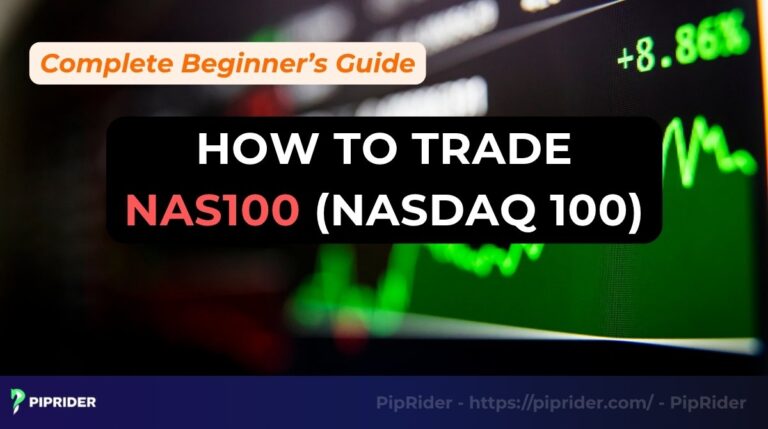Have you ever trusted Bollinger Bands for a breakout, only to watch the price spike out and then immediately reverse? It’s a frustratingly common experience, and if you’ve been caught in that trap, you are not alone. It often leaves traders wondering if there’s a better way to filter out the market noise.
What if there was a similar tool, but one that many traders find to be smoother and more disciplined? This scenario is precisely where the Keltner Channel demonstrates its value.
This guide isn’t just a technical definition. We’re going to break down how the Keltner Channel actually works, compare it head-to-head with the Bollinger Bands so you can see the critical difference, and walk through a practical trading strategy. By the end, you’ll understand why this indicator might be the missing piece you need for your technical analysis to trade trends with more clarity and confidence.
Key Takeaways
- The Keltner Channel uses the Average True Range (ATR) for its calculation, making it a smoother and often less noisy trading indicator than the standard deviation-based Bollinger Bands.
- Its primary strength is in identifying and following stable trends. This makes it a powerful visual aid for determining the market’s trend direction.
- The most reliable methods involve trading trend-following breakouts (with volume confirmation) or buying pullbacks to the middle EMA line.
- Never use it in isolation. Always confirm Keltner Channel signals with a second tool, such as the RSI, MACD, or a volume indicator, to increase accuracy.
1. What is the Keltner Channel?
The Keltner Channel is an envelope-style, volatility-based indicator that wraps around the price on your chart. Its width expands or contracts based on market volatility, and its primary job is to help you identify the trend direction and spot potential trading opportunities.
The Keltner Channel indicator was introduced by grain trader Chester Keltner in his 1960 book How to Make Money in Commodities (Keltner, 1960). It was later refined by trader Linda Bradford Raschke, who popularized the modern version using the Exponential Moving Average (EMA) and the Average True Range (ATR) (Raschke, 1995).

Core components:
- The Middle Line: An Exponential Moving Average (EMA) of the price, typically with a 20-period setting. This acts as the baseline for the trend.
- The Upper Band: The line is plotted by adding a specific ATR-based value to the middle line (EMA).
- The Lower Band: This line is plotted by subtracting that same ATR-based value from the middle line (EMA). The use of ATR is what makes it unique, as it measures true volatility.
This indicator provides a dynamic map of the market’s “normal” price range. The bands often function as shifting areas of support and resistance. Price action consistently in the upper half confirms an uptrend, while movement in the lower half signals a downtrend, making it an invaluable visual guide.
2. How the Keltner Channel works and its formula
The real “magic” behind the Keltner Channel isn’t complicated. It’s simply a clever combination of two well-known indicators: the Exponential Moving Average (EMA) and the Average True Range (ATR). Let’s break down each component.
2.1. The core components explained
What is the EMA?
The Exponential Moving Average (EMA) is a type of moving average that gives more weight to the most recent price data. This weighting allows it to respond faster to shifts in price movements than a Simple Moving Average (SMA) would. The EMA serves as the indicator’s centerline and represents the foundational trend within the Keltner Channel.
What is the ATR?
Average True Range (ATR) makes this indicator unique. Instead of measuring standard deviation like Bollinger Bands, it measures a market’s true volatility by looking at the typical range between the high and low of the price candles. A high ATR reading indicates a volatile market (the Keltner Channel widens), while a low reading suggests a quiet one (the channel tightens).
2.2. The formula for the three lines
Putting it all together, the Keltner Channel plots three lines on your chart based on these simple formulas:
Middle Line: EMA (typically 20 periods)
Upper Band:
| EMA + (ATR Multiplier x ATR) |
Lower Band:
| EMA – (ATR Multiplier x ATR) |
2.3. The most common settings
On most trading platforms like TradingView, the default settings for the Keltner Channel are usually perfect for getting started.
- EMA Period: 20. A solid baseline for swing trading on daily or 4-hour charts.
- ATR Period: 10. This looks at the average volatility over the last 10 candles.
- ATR Multiplier: 2. This is the most crucial setting. A multiplier of 2 is standard and works for most trading styles. A smaller multiplier (like 1.5) will make the Keltner Channel tighter, giving you earlier signals but with more noise. A larger multiplier (like 2.5) creates a wider channel, which is great for filtering out noise but might give you later entry signals.
Read more:
How to master the schaff trend cycle for better entries
A trader’s guide to the Price Rate of Change (ROC) indicator
3. How to use Keltner Channel in trading
How do we actually use the Keltner Channel to make trading decisions? This is where, from our experience, the indicator truly shines. It’s not just about seeing the lines; it’s about understanding the story the price is telling within them.
3.1. Identifying price trends (trend following)
The most intuitive way to use the Keltner Channel is by observing its overall direction. The direction of the entire indicator acts as your visual guide to the trend.
- Uptrend: If the whole Keltner Channel is smoothly angled upwards, and the price is mostly “walking” along the upper band or staying in the top half of the channel, you are in a clear uptrend.
- Downtrend: If the Keltner Channel is pointing downwards and the price is hugging the lower band or staying in the bottom half, it’s a strong downtrend.
Our view: A clean, angled indicator is one of the most beautiful sights for a trend trader. It visually confirms that you are on the right side of the market.
3.2. Trading breakouts
Trading breakouts is where the Keltner Channel often outperforms Bollinger Bands. Because it uses ATR, its breakouts tend to be more reliable.

- The signal: A breakout occurs when a candle closes decisively outside of the upper or lower band. A mere wick poking out isn’t enough; we always wait for the full candle body to close outside the line. This confirms real momentum is behind the move.
- How to use it: When we see a strong candle close above the upper band in an uptrend, it signals that the trend is not just continuing but accelerating. This can be a powerful entry signal to jump on board.
3.3. Trading pullbacks to the EMA
Trading pullbacks to the EMA is a more conservative and higher-probability approach. Instead of chasing breakouts, you wait for the price to come back to you.
The setup: In a clear uptrend (channel pointing up), you wait patiently for the price to pull back and touch the middle line (the 20 EMA). This line acts like a magnet or a “home base” for the price.
The entry: The touch of the EMA isn’t the signal itself. The signal is seeing a bullish reaction right at the EMA, like a pin bar or an engulfing candle. This tells you that buyers have stepped in at the average price, and the trend is likely to resume. This is a great area for entry point.
3.4. Filtering noise in a sideways market
Recognizing when to stay on the sidelines is as crucial as identifying a good trade.
The sign: When the Keltner Channel becomes flat and narrow, it’s screaming at you that the market has no clear direction.
Our advice: This is your cue to stay out. Trying to trade breakouts is a recipe for getting chopped up by small, meaningless moves. The indicator is doing its job by saving you from low-quality setups.
3.5. Combining with RSI or MACD for extra confirmation
Never rely on just one indicator. The real magic happens when you get confirmation from a different type of tool, like a momentum oscillator.
Confirmation for strong moves: Before entering a push above the upper band, glance at your RSI. Is it strong but not yet extremely overbought? This can add confidence that the move has room to run.
Pullback confirmation: When the price pulls back to the EMA in an uptrend, look at your MACD. Do you see the MACD histogram ticking back up or the signal lines preparing for a bullish cross? This is powerful confirmation that momentum is returning in the direction of the main trend.
4. What is the difference between Keltner Channel vs. Bollinger Bands?
This is probably the most common question traders ask when they discover the Keltner Channel. They look similar; they both create envelopes, so what’s the big deal? We can tell you they serve different purposes, and understanding this difference is key.
4.1. The critical difference: ATR vs. standard deviation
The “secret sauce” for each indicator lies in its formula, and it creates a huge difference in behavior.
- Bollinger Bands (BB) use Standard Deviation. Think of this as a hyper-sensitive alarm. A single, large price movement will cause the standard deviation to spike, making the BB bands expand aggressively and immediately. This makes them excellent at showing sudden changes in volatility, a hallmark of Bollinger Bands.
- Keltner Channel (KC) uses the Average True Range (ATR). Think of this as a steady security patrol. It’s based on the average size of the recent candles, so it’s much smoother and less likely to be thrown off by a single wild price spike. This makes it better at identifying the stable, underlying trend.
Here is a simple, visual comparison table that summarizes the key differences between the two indicators.
| Feature | Keltner Channel | Bollinger Bands |
| How It’s calculated | Based on Average True Range (ATR). | Based on Standard Deviation. |
| Band behavior | Smoother and more uniform. Less reactive to single price spikes. | More dynamic and aggressive. Expands and contracts sharply with volatility. |
| Primary strength | Identifying and riding stable trends. Excellent for filtering noise. | Detecting volatility expansions (the “Squeeze”). |
| Best for | Trend-following and pullback strategies. | Mean-reversion strategies and trading “the Squeeze”. |
| Watch out for | Can be slower to react to a sudden explosion in volatility. | Can give many false continuation signals in a strong trend. |
| Our take | A go-to tool for trend clarity and reducing fakeouts. | The preferred tool for strategies that specifically trade volatility itself. |
4.2. When traders prefer to use the Keltner Channel
The Keltner Channel is superior in these situations:
- For trend following: If you want to identify a smooth, steady trend and ride it, the Keltner Channel is your best friend. Its lines are less chaotic and provide a clearer picture of the main direction.
- For pullback entries: The EMA middle line of the Keltner Channel is, in our opinion, a more reliable “home base” for price pullbacks within a trend.
- To avoid being faked out: If you’re tired of being faked out by moves that immediately reverse, the smoother nature of the Keltner Channel helps filter out a lot of that noise.
4.3. When Bollinger Bands might be a better choice
The Bollinger Bands still have their place, particularly for traders focused on volatility itself.
- For “the squeeze”: The classic Bollinger Band Squeeze method, where the bands get extremely narrow to signal a massive pending move, is unique to this indicator.
- For mean reversion in ranging markets: Because the bands react so aggressively, a price touching the outer band in a sideways market can be a stronger signal that the price is overbought or oversold and likely to revert to the middle. This is a classic Bollinger Bands tactic.
4.4. A powerful pro-tip: Using them together
You don’t have to choose. Some of the most powerful trading signals occur when you combine them. The “Squeeze” strategy, popularized by John Carter, involves putting the BB inside a Keltner Channel.
The setup: You wait for a period of extremely low volatility where the Bollinger Bands actually go inside the Keltner Channel bands.
The signal: When they finally expand out of the Keltner Channel, it signals that a potentially explosive move, often triggered by this very event, is beginning. This is a very strong confirmation.
So, the final verdict? For general trend identification and riding, we lean on the Keltner Channel. For strategies based purely on volatility spikes, they have the edge.
5. Popular trading methods with the Keltner Channel
Now for the best part: putting the Keltner Channel to work. We are going to walk you through three common strategies we’ve used. Remember, no approach is foolproof, but these rule-based setups provide a solid foundation for making objective trading decisions.
5.1. The Trend Continuation Breakout Strategy
The trend continuation breakout strategy is an aggressive approach designed to catch a trend that is not just continuing but accelerating with force.

The logic: In a strong trend, a decisive close outside the channel isn’t a sign of reversal. Instead, it often signals a burst of momentum and that the “herd” is jumping in. We use this to ride the wave.
The trading rules:
- Identify the trend: The Keltner Channel must be clearly sloped up (for a buy) or down (for a sell). If it’s flat, this strategy is off-limits.
- Wait for the breakout: Wait for a candle to close decisively outside the upper or lower band. A strong, full-bodied candle is what you want to see.
- Confirm with volume: This is a crucial step. Look at your volume indicator. The breakout candle should be accompanied by a spike in volume, which confirms there is real conviction behind the move.
- Entry: Enter a trade at the start of the next candle.
- Stop loss: Place your stop loss just inside the channel, near the middle EMA line. This is a good way to practice risk management.
5.2. The EMA Pullback (or Mean Reversion) Strategy
The EMA pullback strategy is our favorite because it’s more conservative and often provides a better risk-to-reward ratio. You aren’t chasing the price; you’re letting it come back to a logical area of value.

The logic: The chart shows that a healthy trend doesn’t move in a straight line. It ebbs and flows. It often pulls back to its average price (the EMA) before continuing. This pullback is viewed as a value opportunity, a chance to enter the trend at a more favorable price.
The trading rules:
- Identify the trend: Again, the Keltner Channel must be clearly angled up or down.
- Wait for the pullback: Patiently watch as the price pulls back to touch the middle line (20 EMA). This is your zone of interest, not your entry points trigger.
- Wait for confirmation: This is the most important step. Watch for a specific price action signal indicating that buyers are taking control (in an uptrend). This could be a bullish pin bar, an engulfing candle, or a small consolidation right at the EMA.
- Entry: Enter after the confirmation candle has closed. A well-calculated position size is crucial here.
- Stop loss: Your stop should be positioned just underneath the low point of the confirmation candle. This is also a good area for setting exit points.
5.3. The Sideways Market Reversal Strategy
While the Keltner Channel is best in trends, you can use it in ranging market conditions, but you must be disciplined.

The logic: Based on the chart, when the Keltner Channel is flat, the outer bands represent overextended areas where the price can be considered overbought or oversold. The strategy operates on the expectation that the price will move back toward its average (the middle EMA).
The trading rules:
- Identify the range: The Keltner Channel must be horizontal and relatively narrow.
- Wait for the touch: Allow the price to make contact with either the upper or lower Keltner Channel boundary.
- Look for rejection: You need strong confirmation that this area of support and resistance is holding. Look for a bearish candle pattern (like a shooting star) at the upper band, or a bullish pattern at the lower band.
- Entry: Enter after the rejection candle closes. This can also serve as a useful exit points for trades.
- Stop loss & target: Place your stop loss just outside the Keltner Channel, beyond the high/low of the rejection candle. Your primary target is the middle EMA line.
6. The pros and cons of the Keltner Channel
No indicator is perfect, and the Keltner Channel is no exception. Understanding its strengths and weaknesses is what separates a smart trader from one who just blindly applies a tool. Here’s a realistic breakdown.
6.1. The advantages (the good stuff)
Traders value the Keltner Channel for several key strengths that can enhance their market analysis:
- Effective noise filtering: This is its biggest strength. Because it uses the ATR, the Keltner Channel doesn’t overreact to every little price spike. This results in fewer false signals and a much cleaner view of the market, which honestly does wonders for your trading psychology.
- Smooth trend following: The smooth, steady nature of the bands makes identifying and following a trend incredibly intuitive. You can visually see the strength and trend direction without the chaotic expansions and contractions you might see elsewhere.
- Simple interpretation: The logic is straightforward. For instance, an uptrend is clearly defined when the price holds above the middle line while the Keltner Channel itself is angled upward. There are no complex calculations or multiple lines to decipher, making it very beginner-friendly.
6.2. The disadvantages (the reality check)
However, like any technical tool, it has limitations that traders must be aware of to avoid common pitfalls:
- Delayed reaction to market volatility: The same ATR-based calculation that makes the Keltner Channel smooth can also cause it to be slow to react to sudden bursts of volatility, potentially causing you to miss the start of a strong move.
- The absolute need for confirmation: This is non-negotiable. The Keltner Channel is a team player, not a solo star, and relying on it alone for trading decisions is a significant mistake. A signal, for example, needs to be confirmed by a surge in trading volume.
6.3. When you SHOULD and SHOULD NOT use it
Here’s our simple rulebook for applying it:
You SHOULD use it when:
- The market is in a clear, established trend (either up or down).
- You want to trade conservative pullback strategies.
- Your primary goal is to filter out market noise and avoid getting faked out.
You SHOULD NOT use it when:
- The market is moving sideways with choppy, unpredictable price movements.
- You are trying to trade very low-volatility, “dead” markets where the price is barely moving.
- You are trying to scalp news-driven events that cause massive, sudden volatility spikes. Other tools are better suited for that specific job.
7. Common mistakes to avoid when using the Keltner Channel
Let’s talk about mistakes. We’ve made every single one of these when we were starting out, and they are the fastest way to lose confidence in a perfectly good indicator. Avoiding these traps is just as important as learning the strategies.
7.1. Using it in isolation without confirmation
You see the price touch the upper band, and you immediately sell, without any other signal.The reality: Think of the Keltner Channel as a map showing potential areas of interest, not as a GPS that tells you exactly when and where to enter. It shows you where the interesting support and resistance levels are, but it doesn’t tell you when to act. This is especially true in market conditions where price can remain overbought or oversold for extended periods.

How to avoid it: Make it a rule to always seek a secondary confirmation. A signal needs to be confirmed by Volume. A reversal or pullback signal requires validation from a price action candle (like a pin bar) or an oscillator like the RSI.
7.2. Trying to force a trend in a sideways market
You see the price push out of a flat, narrow Keltner Channel and you jump in, expecting a big trend to start, only to get stopped moments later.
The reality: When the Keltner Channel is flat, it’s telling you the market is in equilibrium and has no desire to trend. Trying to use a trend-following method here is like trying to sail a boat with no wind.
How to avoid it: When the Keltner Channel goes flat, your mindset must change. Either stay out of the market entirely or switch to a short-term, mean-reversion strategy, targeting the middle EMA line instead of a big move.
7.3. Assuming it’s the same as Bollinger Bands
Because they look similar, many traders apply Bollinger Bands strategies directly to the Keltner Channel, such as looking for a “Squeeze” in the same way.
The reality: They are cousins, not twins. They are calculated differently (ATR vs. Standard Deviation) and behave differently. The Keltner Channel is smoother and better for trends, while the BB are more reactive and better for volatility spikes.
How to avoid it: Treat them as two separate tools in your toolbox. Know why you are choosing one over the other for specific market conditions.
7.4. Over-complicating the settings
A new trader will endlessly tweak the EMA period, ATR period, and multiplier, trying to find a “perfect” combination that never loses. The search for perfect customization is often a trap.
The reality: This leads to curve-fitting and a complete lack of consistency. You end up with settings that worked perfectly for last week’s price action but fail in the live market.
How to avoid it: Start with and master the default settings (20, 10, 2). There is no magic number. A profitable method comes from consistent execution, not from finding secret parameters. A useful technique for testing is backtesting.It all boils down to this single piece of advice we wish we had learned sooner:
“A simple tool that you understand deeply is far more effective than a complex one whose nature you don’t grasp.”
8. FAQs – Frequently Asked Questions
Here are some quick answers to the most common questions traders have about the Keltner Channel.
9. Conclusion: Is the Keltner Channel worth a spot on your charts?
So, after everything, we land on the final question: should you use the Keltner Channel? Our answer is a resounding yes, especially if you are a trader who values clarity and wants to follow the main trend.
Its greatest strength lies in its simplicity. For traders who are new to the markets or feel overwhelmed by noise, the Keltner Channel provides a clean, intuitive, and visual way to see what the market is doing. It can absolutely serve as a core tool in your arsenal for identifying the trend direction and spotting high-quality continuation opportunities.
However, the most important lesson to take away is that it should never be used in isolation. The most successful traders we know build a system, and a key part of that is confirming your signals. By combining the Keltner Channel with a momentum oscillator like the RSI or MACD, you create a much more robust and reliable technical analysis.
Your learning journey doesn’t stop here. To discover more powerful tools and strategies, make sure to follow us here at Piprider and check out our growing library in the Learn Forex category.








